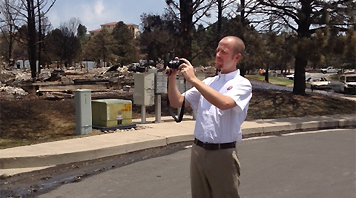|
RMIIA News Releases7951 E. Maplewood Avenue, Suite 110 Contact: Carole Walker, Executive Director WILDLIFE ON THE MOVE! September 1, 2011 – Today, roadside reminders are back in the form of lowered nighttime speed limits and/or doubled fines for nighttime speeding within designated Wildlife Zones. Motorists will see more roadside reminders to slow down and watch for wildlife in specifically designated corridors. Legislation sponsored by Senator Gail Schwartz and former Representative Kathleen Curry (and several non-governmental organizations) in 2010 called for lowered nighttime speeds and doubled fines in designated "wildlife crossing zones" from September 1 through April 30. (Signs along Region 5 highways, however, carry the enforcement through May, as data show a major spring migration across this corridor during the first two weeks of May.) There are no fines for hitting an animal. Per the HB 1238 (2010), the Colorado Department of Transportation identified 100 miles of wildlife crossing zones where lowered nighttime speed enforcement was feasible. CDOT set signs within the zones (see chart, below) and will continue to collect data and report back on results of this pilot initiative in the spring of 2012. CDOT worked closely with representatives of the Colorado State Patrol and the (newly named) Division of Parks and Wildlife—using several comprehensive data sources—to identify these zones. Nighttime speeds were reduced to 55 mph only where the current speeds are posted at 60 or 65 mph. The nighttime speed is enforced with double fines between the hours of 5 P.M. and 7 A.M. While it is not yet dark at 5 P.M., the timeframe was selected based on the extended dusk to dawn hours throughout the migration season, reflecting the time of day during which the majority of wildlife-vehicle collisions take place. Some sections of highway (see chart) were signed "WILDLIFE CORRIDOR" but the nighttime speed has remained the same—fines will still be doubled for speeding in ALL zones, however. "The CSP will continue our enforcement efforts in the wildlife zones, and the good news after 15 months is that we are seeing a reduction in crashes for some areas," Colorado State Patrol (Troop 4C, Glenwood) Captain Rich Duran said. "This could be directly attributed to the signage and speed reductions, but we'll have to review all data at the end of this pilot initiative to know for sure." Wildlife-vehicle collisions happen year round, 24/7. However, there is always an increase during migration season, and particularly during the hours between dusk and dawn. These collisions are not only a matter of safety, but can be quite costly as well. "The insurance industry pays out nearly $1.1 billion a year in claims for all wildlife-vehicle collisions nationwide; a big portion of that is in the fall, and in particular November, when these types of collisions increase," Carole Walker, Executive Director of the Rocky Mountain Insurance Information Association said. "The average property damage cost of animal-vehicle collisions is estimated at $3,103, up 1.7 percent from a year ago." During wildlife migration season, motorists are urged to follow these important safety tips:
WILDLIFE ZONES
Rocky Mountain Insurance Information Association is a non-profit consumer information organization. Affiliated with the Insurance Information Institute, RMIIA has been serving consumers and the media since 1952. |
|
303-790-0216 • 800-355-9524 • Contact Us • Legal Notice, Disclaimer & Terms of Use
Home • About RMIIA • News Room • P&C Insurance Industry • Auto • Homeowners • Business • Catastrophes • Agent Resources • Events & Education • Brochures

